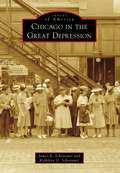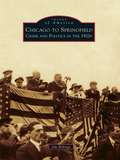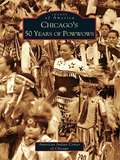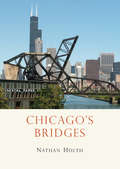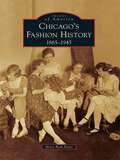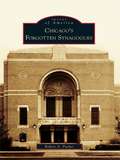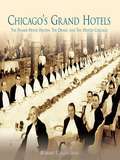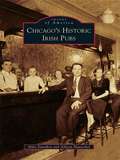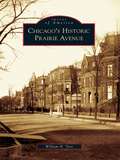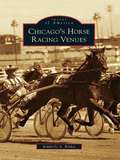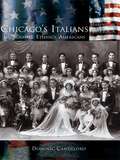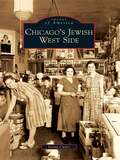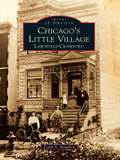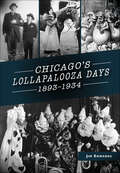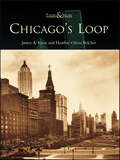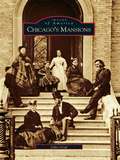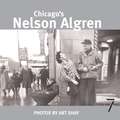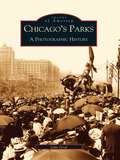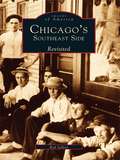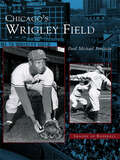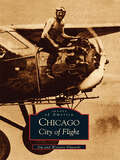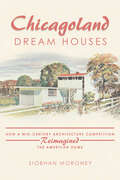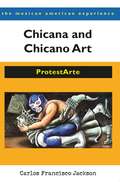- Table View
- List View
Chicago in the Great Depression
by James R. Schonauer Kathleen G. SchonauerCarl Sandburg called Chicago the "City of the Big Shoulders," and those shoulders withstood the stock market crash of 1929. Chicagoans rallied to collect funds to celebrate the centennial of the city's incorporation in 1833. A Century of Progress International Exposition, held in 1933 and 1934, brought jobs and businesses to Chicago and cheered people with the prospect of new technology and the promising face of the future. Neighborhood churches and community organizations helped each other, and the Great Migration brought new arrivals from the American South. Together, these factors helped to hasten the end of Prohibition and the fall of notorious gangsters like Al Capone and John Dillinger. Jazz rolled in, with Chicagoans dancing along to the tunes of the big bands. Even if pocketbooks were bare, souls were full of hope.
Chicago to Springfield: Crime and Politics in the 1920s (Images of America)
by Jim RidingsThe story of Chicago gangsters in the 1920s is legendary. Less talked about is the tale of the politicians who allowed those gangsters to thrive. During the heyday of organized crime in the Prohibition era, Chicago mayor "Big Bill" Thompson and Gov. Len Small were the two most powerful political figures in Illinois. Thompson campaigned on making Chicago "a wide open town" for bootleggers. Small sold thousands of pardons and paroles to criminals, embezzled $1 million, and was then acquitted after mobsters bribed the jury. This book is the story of those Jazz Age politicians whose careers in government thrived on and endorsed corruption and racketeering, from Chicago to Springfield. It complements author Jim Ridings's groundbreaking biography, Len Small: Governors and Gangsters, which was praised by critics and situated Ridings as a trailblazer among Chicago crime authors.
Chicago's 1933-34 World's Fair: A Century of Progress
by Bill CotterIt took six years and cost $100 million, but on May 27, 1933, the gates swung open on the biggest birthday party the city of Chicago had ever seen. The Century of Progress Exposition, better known as the 1933-34 Chicago World's Fair, commemorated the amazing progress that had been made since the founding of the city just 100 years earlier. Many of America's largest companies joined with countries from around the world to showcase their histories and advertise their newest products. The road to opening day was not an easy one, with the Great Depression making it look like the fair might never be built, but thousands of small investors stepped forward to help close the financial gap. The fair went on to an unprecedented second season, and when the gates finally closed after the last of the 39 million visitors went home, it had achieved something quite rare among world's fairs: earning a profit. This collection of rare photographs, previously unpublished, highlights the major attractions of the fair and the astonishing changes made between seasons.
Chicago's 50 Years of Powwows (Images of America)
by American Indian Center of ChicagoSince 1953, the American Indian Center of Chicago has hosted an annual powwow. The powwow is the centerpiece of contemporary Indian culture. It is how Native Americans celebrate traditional values and share their culture with a wider audience. The powwow is a place to make and rekindle friendships. It offers an opportunity to reaffirm traditional values and a chance to reconnect with family, friends, and the greater community. It is a celebration of artistic and cultural traditions, and a way of transmitting those traditions to a younger generation. Through an extensive collection of representative images, Chicago's 50 Years of Powwows chronicles the exciting history and traditions of the powwow.
Chicago's Bridges
by Nathan HolthStretching more than 150 miles and cutting through the city that bears its name, the Chicago River divides the Second City into the North Side and the South Side. In 1832, the first bridge across the river was constructed. In 1834, the first moveable bridge was erected. Today, Chicago is home to nearly 40 moveable bridges and some 60 bridges in all, making it the most bridge-rich city in the world. The River and its bridges have done much to shape the history of Chicago, which has grown from a rough-and-tumble trading outpost to a world-class city known for its architecture. Chicago's Bridges traces the evolution of the city's bridges, from the origins of the unique bascule bridges that punctuate the Chicago River to the splendidly designed bridges that lend Chicago its reputation as one of the great architectural destinations of the world.
Chicago's Fashion History: 1865 - 1945
by Mary Beth KlattFrom the ashes of the Chicago Fire of 1871 came the birth of the city's fashion scene as entrepreneurs built new storefronts virtually overnight. Aided by the Windy City's incredible network of railroads, these fledgling enterprises in turn created millionaires who wanted to wear the latest clothes from Europe. Marshall Fields and Potter Palmer were among the local elites who regularly boarded ships to France and returned with exquisite suits, coats, hats, gowns, fabrics, and other accessories, which designers sought to re-create with cheaper fabrics and labor. Chicago's reputation as a trendsetting metropolis was only sealed by the city's film industry. Charlie Chaplin and his cast of stylish starlets had women north and south of Madison Street copying every hairdo and dress. Even after moviemaking moved to Los Angeles, actors and actresses traveling to New York City regularly dropped in when they switched trains downtown. By World War II, Chicago, the "City of Big Shoulders," became the place to start a career as a fashion designer.
Chicago's Forgotten Synagogues (Images of America)
by Robert A. PackerThe disappearing history of Chicago's Jewish past can be found in the religious architecture of its stately synagogues and communal buildings. Whether modest or majestic, wood or stone, the buildings reflected their members' views on faith and their commitment to the neighborhoods where they lived in a time when individuals and the community were inseparable from their neighborhood synagogues, temples, and shuls. From Chicago's oldest Jewish congregation, Kehilath Anshe Maariv Temple (Pilgrim Baptist), to Ohave Sholom (St. Basils Greek Orthodox), to Kehilath Anshe Maariv's last independent building (Operation Push), come and explore Chicago's forgotten synagogues and communal buildings. Nearly 150 years of Chicago history unfolds in Chicago's Forgotten Synagogues as the photographs and accompanying stories tell of the synagogues' past greatness and their present and uncertain future.
Chicago's Grand Hotels: The Palmer House Hilton, The Drake, and The Hilton Chicago
by Robert V. AllegriniArchitecturally imposing, historically rich, and socially important, Chicago's magnificent grand hotels have fascinated generations of Chicagoans and have pleased generations of guests. The Palmer House Hilton, The Drake, and The Hilton Chicago have come to represent a collective formal living room for Chicago, where the city's most important visitors are accommodated, entertained, and made aware of the grandeur and sophistication of their host's hometown. They were built to inspire awe--and still do for anyone fortunate enough to find themselves in the lobby of The Palmer House Hilton, The Palm Court of The Drake, or the Grand Ballroom of The Hilton Chicago.Many of the most famous locales in these classic structures have been transformed or have disappeared altogether due to changing times. Gone, for example, is The Hilton Chicago's famous rooftop miniature golf course and Boulevard Room supper club, complete with its ice shows. Gone, too, is The Drake's legendary supper club, the Camellia House. While the Empire Room of The Palmer House Hilton continues to exist as an function room, it no longer reverberates with the sound of Liberace's piano or Jimmy Durante's vocals, as it did when it was the city's premier entertainment facility. Chicago's Grand Hotels chronicles over 100 years of Chicago hotel history through vivid photographs and memorabilia from the archives of The Palmer House Hilton, The Drake, and The Hilton Chicago. It tells the compelling story of the visionary architects and hoteliers who brought these hotels to life and made them structural testaments to the warmth of midwestern hospitality.
Chicago's Historic Irish Pubs (Images of America)
by Allison Hantschel Mike DanaheyFrom dancing at Hanley's House of Happiness to raising pints at Kelly's Pub on St. Patrick's Day, the history of the Irish community in Chicago is told through stories of its gathering places. Families are drawn to the pub after Sunday church, in the midst of sporting events, following funerals, and during weddings. In good times and bad, the pub has been a source of comfort, instruction, and joy--a constant in a changing world. Based on interviews with tavern owners, musicians, bartenders, and scholars, Chicago's Historic Irish Pubs explores the way the Irish pub defines its block, its neighborhood, and its city.
Chicago's Historic Prairie Avenue (Images of America)
by William H. TyrePrairie Avenue evolved into Chicago's most exclusive residential street during the last three decades of the 19th century. The city's wealthiest citizens--Marshall Field, Philip Armour, and George Pullman--were soon joined by dozens of Chicago's business, social, and civic leaders, establishing a neighborhood that the Chicago Herald proclaimed "a cluster of millionaires not to be matched for numbers anywhere else in the country." Substantial homes were designed by the leading architects of the day, including William Le Baron Jenney, Burnham and Root, Solon S. Beman, and Richard Morris Hunt. By the early 1900s, however, the neighborhood began a noticeable transformation as many homes were converted to rooming houses and offices, while others were razed for construction of large plants for the printing and publishing industry. The rescue of the landmark Glessner house in 1966 brought renewed attention to the area, and in 1979, the Prairie Avenue Historic District was designated. The late 1990s saw the rebirth of the area as a highly desirable residential neighborhood known as the South Loop.
Chicago's Horse Racing Venues
by Kimberly A. RinkerThe popularity of horse racing in Chicago has yet to be rivaled in any other metropolitan area. Since the 1800s, the Windy City's enthusiasm for both harness and Thoroughbred racing led to 10 major racetracks being built in the Chicago area. Four of those raceways--Balmoral, Maywood, Hawthorne, and Arlington--are still racing and thriving today. From Washington Park, Lincoln Fields, and Worth Raceway on the city's South Side, to the Near West Side venues of Hawthorne Race Course and Sportsman's Park, to Arlington Park's northwest locale and Aurora Downs to the west, Chicago's racing community has enjoyed a long and sometimes scandalous history. Chicago's Horse Racing Venues provides insight into Chicago's rich racing history and a behind-the-scenes look at the people and horses involved.
Chicago's Italians: Immigrants, Ethnics, Americans (Making of America)
by Dominic CandeloroSince 1850, Chicago has felt the benefits of a vital Italian presence. These immigrants formed much of the unskilled workforce employed to build up this and many other major U.S. cities. From often meager and humble beginnings, Italians built and congregated in neighborhoods that came to define the Chicago landscape. Post-World War II development threatened this communal lifestyle, and subsequent generations of Italian Americans have been forced to face new challenges to retain their ethnic heritage and identity in a changing world. With the city's support, they are succeeding.
Chicago's Jewish West Side (Images of America)
by Irving CutlerFor nearly half a century, the greater Lawndale area was the vibrant, spirited center of Jewish life in Chicago. It contained almost 40 percent of the city's entire Jewish population with over 70 synagogues and numerous active Jewish organizations and institutions, such as the Jewish People's Institute, the Hebrew Theological College, and Mount Sinai Hospital. Its residents included "King of Swing" Benny Goodman, Israeli prime minister Golda Meir, journalists Irv Kupcinet and Meyer Levin, federal judge Abraham Lincoln Marovitz, civil rights attorney Elmer Gertz, Eli's Cheesecake founder Eli Shulman, and comedian Shelley Berman. Many of the selected images come from the author's extensive collection. This book will bring back memories for those who lived there and retell the story of Jewish life on the West Side for those who did not. No matter where the scattered Jews of Chicago live now, many can trace their roots to this "Jerusalem of Chicago."
Chicago's Little Village: Lawndale-Crawford
by Frank S. MagallonLittle Village has been known by several names over the past 140 years, but its rich culture and history have never been forgotten. Situated on Chicago's southwest side, Little Village has gone from real estate promoters Millard and Decker's affluent "suburb" Lawndale to one of the largest Bohemian enclaves in the United States. This vibrant neighborhood is known today as the largest Mexican community in the state of Illinois. Little Village has almost always been a working-class immigrant neighborhood filled with hardworking men and women who want their piece of the American dream. From residents such as martyred Chicago mayor Anton Cermak to the typical immigrant family next door, these strong-willed people have made their mark on Chicago and the rest of the world.
Chicago's Lollapalooza Days: 1893-1934
by Jim EdwardsChicago has been called by many names--that Toddlin' Town, the Windy City (for its politicians, not weather) and Chi-town, to name a few. Today, it might be called Lollapalooza Land after its fun-loving and somewhat rowdy summer fest. But this nickname tracks back to 1908's boisterous Democratic Party fundraiser for the city's 1st Ward political machine. Chicago, from 1893 to 1934, was indeed alive with raucous people, as well as reformers, and this book not only tells their fascinating stories but also the following: Chicago's first McDonald's served up beer and politics, not burgers; the devil embodied Clark Street, but its tail swished all the way north to the opera; the city was a cartoonist's paradise; world-famous artists, writers, singers, and musicians drew, wrote, sang, and played in Chicago; and the Levee District boasted two madame sisters who ran a world-famous palace of pleasure. Readers will also meet a prizewinning horse without pants, wonder over an elephant named Princess Alice, hear of the world's biggest red wagon, find out about the first dinosaur in town, and discover how Chicago helped mother jazz, ragtime, and the blues.
Chicago's Loop (Then and Now)
by Heather Olivia Belcher Janice A. KnoxFrom 19th century trading post to one of the world's great financial, business, and entertainment districts, experience the growth and changes of the Windy City.Chicago's famed Loop is said to have gotten its name from the route of a cable car that looped the central business district in 1882. Since then, much has changed.This book captures the evolving urban landscape of the Chicago Loop, with a collection of over 100 vintage images, each coupled with its contemporary counterpart. Few cities are as renowned for their architecture as is Chicago. The impressive skyscrapers in and around the Loop give Chicago a skyline second to none. And with more than three dozen historic landmarks, the Loop is home to many of the city's most recognized structures.Authors Janice A. Knox and Heather Olivia Belcher are both native Chicagoans and collectors of Chicago memorabilia. Together they have created a book that shows us the Chicago we know and love today, along with a clear echo of the city's rich, ever-changing landscape.
Chicago's Mansions
by John GrafChicago is known throughout the world for its architecture. Although many people are familiar with the city's skyscrapers and public buildings, they often overlook or are unaware of Chicago's mansions that are located throughout the city. These mansions represent Chicago's past and its future, and it can even be said that they are the very embodiment of Chicago and its architecture. These fashionable residences were built to make a statement, and what better way to have done this than to employ the leading architects of the time to design them. These architects included men such as Louis Sullivan, Frank Lloyd Wright, Henry Hobson Richardson, Daniel Burnham, and John Wellborn Root. While the city's mansions are significant because of who built them, they are just as important because of who lived in them. Many of these mansions were built for Chicago's elite businessmen and captains of industry-men who represented old money, new money and big money. Just as important were the families of these men and the other residents who came to live in these mansions-for they left a legacy of their own that contributed to the city's history.
Chicago's Nelson Algren
by David Mamet Art ShayThey met in 1949 when Art was a reporter for Life. Shay followed Algren around with a camera, gathering pictures for a photo-essay piece he was pitching to the magazine. Life didn't pick up the article, but Shay and Algren became fast friends. Algren gave Shay's camera entrance into the back-alley world of Division Street, and Shay captured Algren's poetry on film. They were masters chronicling the same patch of ground with different tools.Chicago's Nelson Algren is the compilation of hundreds of photos--many recently discovered and published here for the first time--of Nelson Algren over the course of a decade and a deeply moving homage to the writer and his city. Read Algren and you'll see Shay's pictures; look at Shay's photos and you'll hear Nelson's words.
Chicago's Parks: A Photographic History
by John GrafNo other city in the world has a park system as great as Chicago's, which includes over 550 parks totaling more than 7,000 acres. Each park has its own story, as well as unique characteristics and history, and yet the majority of Chicagoans are not aware of the wealth, variety, and sheer number of parks that exist, to say nothing of the ideas theyproject, the history they commemorate, and the origins of their names. Chicago's Parks: A Photographic History seeks to remedy this oversight. From Chicago's first park, Dearborn Park, to its more famous parks of Grant and Lincoln, this book provides a wealth of information concerning the origins of the names and plans of these Chicago landmarks. A formal plan for the creation of a park system was developed in 1869, and soon Chicago had some of the greatest parks to be found anywhere in the world. When Chicago was founded in 1837, the city's fathers adopted the motto urbs in horto, or "the city set in a garden." Despite the numerous changes that have taken place over the past 160 years, Chicago is still a city set in a garden. Chicago's Parks: A Photographic History captures the growth of that "garden" with its nearly 200 historic photographs.
Chicago's Polish Downtown
by Polish Museum of America Victoria GranackiPolish Downtown is Chicago's oldest Polish settlement and was the capital of American Polonia from the 1870s through the first half of the 20th century. Nearly all Polish undertakings of any consequence in the U.S. during that time either started or were directed from this part of Chicago's near northwest side. This book illustrates the first 75 years of this influential Polish neighborhood. Featured are some of the most beautiful churches in Chicago-St. Stanislaus Kostka, Holy Trinity, and St. John Cantius-stunning examples of Renaissance and Baroque Revival architecture that form part of the largest concentration of Polish parishes in Chicago. The headquarters for almost every major Polish organization in America were clustered within blocks of each other, and four Polish-language daily newspapers were published here. The heart of the photographic collection in this book is from the extensive library and archives of the Polish Museum of America, still located in the neighborhood.
Chicago's Southeast Side Revisited
by Rod SellersOne of the phrases that has been used to describe Chicago's Southeast Side is "smokestacks and steeples." The community initially developed because of the steel industry, but it has been affected by the decline of the American steel industry in recent years. Today, the people of South Chicago, South Deering, the East Side, and Hegewisch look to the future. The community is, in many respects, at a crossroads. Will economic redevelopment occur, and if it does, at what price? Will the ecology and environment, damaged by years of abuse and neglect, be restored and protected?This second book about the region tells the story of this interesting and vibrant Chicago community from a chronological approach. It looks at important themes of American history from the perspective of this urban, working-class community. Industrialization, urbanization, unionization, immigration, and Americanization were themes that played out on the Southeast Side of Chicago. It examines how the community dealt with problems like depression, wars, pollution, and the decline of heavy industry-especially the steel industry.
Chicago's Wrigley Field (Images of Baseball)
by Paul Michael PetersonWrigley Field is the second oldest ballpark currently in use in the major leagues, but it ranks first in the hearts of Cubs fans. Rooting for the home team from the corner of Clark and Addison to small towns and city streets across the country, generations of Cubs' fans have made that summer pilgrimage to the home of Gabby Hartnett's "Homer in the gloamin'" that clinched the 1938 pennant, Hack Wilson's record 190 RBI season, Ernie Banks' 500th career home run, Sammy Sosa's 60 plus home run seasons, and Kerry Wood's 20-strikeout masterpiece. It was originally built as Wheeghman Park in 1914 to host the Chicago Whales of the upstart Federal League. The Cubs moved in two years later, and, with an 11-inning 7-6 victory over the rival Cincinnati Reds, one of the greatest traditions in all of American sports was established: National League baseball at Chicago's picturesque north side ballpark. Renamed Cubs Park in 1920 and finally Wrigley Field in 1926, the hallmark bricks and ivy, hand operated scoreboard, and high flying "W" (or, regrettably, "L") flag over Wrigley have become longstanding symbols of summertime in the city.
Chicago: City of Flight (Images of America)
by Jim Edwards Wynette EdwardsSince the late 1800s, Chicago has been a mecca for aviation. Chicago's Octave Chanute kept the skies filled with revolutionary gliders and his expertise in aeronautics contributed to the Wright Brothers' success. Chicago: City of Flight tells the story of aviation in the city with exciting chapters on early "birdmen," the birth of Chicago as a major airmail center, the spectacular chills and thrills of international airports and airplane manufacturers, and airlines, such as United Airlines, that were born in the city. Later topics include the city's modern aerospace industry and an exclusive look at Chicago's Wright Redux project, members of which designed and manufactured a replica Wright flyer. They plan to fly it over the city on December 17, 2003, in celebration of 100 years of manned, powered flight.
Chicagoland Dream Houses: How a Mid-Century Architecture Competition Reimagined the American Home
by Siobhan Moroney“Chicagoland Dream Houses is an engaging addition to the growing body of scholarship concerning Chicago’s twentieth-century residential landscape characterized by a diverse group of architects and builders.”--Michelangelo Sabatino, coauthor of Modern in the Middle: Chicago Houses 1929–1975
Chicana and Chicano Art
by Carlos Francisco JacksonThis is the first book solely dedicated to the history, development, and present-day flowering of Chicana and Chicano visual arts. It offers readers an opportunity to understand and appreciate Chicana/o art from its beginnings in the 1960s.
